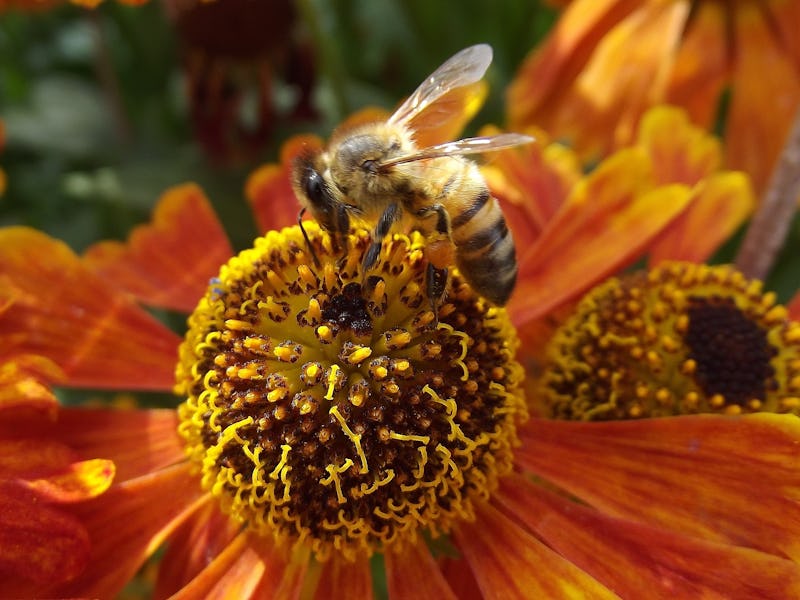Good News for Honeybees: 2016 Population Results are Not "Horrible"
Long live bees. 🐝

A survey of nearly 5,000 beekeepers across the United States has found a third of the bees they managed died between April 2016 and March 2017. That stat sounds horrible, but it’s not as bad as one would think.
Bees have dealt with serious challenges over the last thirty years, says Dennis vanEngelsdorp, Ph.D., an assistant professor of entomology at the University of Maryland. He’s also project director for the Bee Informed Partnership, which conducted the survey. He stops short of calling the latest data good news.
“We had gone from a situation that was horrible where were losing 50 percent of our colonies per year to one where it’s really bad, which is 30 percent. It’s better than it was, but that doesn’t make it good,” vanEngelsdorp tells Inverse.
The results are slightly better because of a milder winter, which helps for obvious reasons, but also for a milder summer, which helped beekeepers fight off the biggest new enemy of bees.
Whenever someone asks you, “Why are the bees dying?” you can quickly rattle off these three reason: mites from Asia, introduced 30 years ago; pesticides; and poor bee nutrition.
Honey bee colony loss estimates.
Varroa Mites and the Viruses They Carry
Enter the varroa mite, which started infesting honey bee colonies after coming into Florida in the mid-1980s. The European honeybee — which comprises most honeybee races in North America — has no innate immunity against viruses carried by the varroa mite, and in the last 30 years the viruses have become more virulent because of how they are transmitted between mites. All of which is to say that 20 mites among 100 bees was a concern 20 years ago, but today three mites among 100 bees carries the same threat level.
These mites are the biggest problem for honeybees, bar none.
“Before varroa mite, I think that we thought that a beekeeper would be embarrassed if they lost 10 percent over the winter,” vanEngelsdorp says. “In the 1970s, ten percent was sort of unheard-of. That would be a very high rate of loss. However, we sort of have moved now into an era with varroa and we ask that question to beekeepers — ‘what do you think a reasonable rate of was loss is?’ — and they’re saying it’s probably somewhere around 15 percent. I think that 15 percent over the course of the year is probably a good target.”
Mite levels were also lower in the fall of 2016, in part because an essential oil in mite control products — which breaks down at hot temperatures — didn’t break down during the milder weather.
Pesticides, Fungicides, and Insecticides
Pesticides, fungicides, and insecticides pose another tricky challenge for bees and their keepers, who can’t control what chemicals farmers put on their crops that bees go near. Additionally, the effects of chemicals on bees are more subtle and take longer to show up.
“Bees don’t die right away from [pesticides]; a colony can lose 30 percent of its bees and still be a healthy colony because it’s a super organism and can absorb some shock, and lose members without the colony suffering,” vanEngelsdorp explains. “The problem is that some of these problems have a delayed effect. Three or four months after the exposure the colonies are more likely to die. I think the EPA has never had to address that longer-term issue. They are working to try to develop new ways of testing and making sure that products are safe for bees.”
Poor Nutrition
This one is easy: Honey bees collect pollen and nectar for the entire colony, which is converted to honey and to feed bee larvae. When there are less natural sources, it becomes tougher to find proper food and the colonies as a whole become less healthy. Not helping matters: A lot of land that used to be natural meadow are now heavily controlled and chemical-covered farm fields.
Bee colony loss by state. Oklahoma was the worst hit in 2016.
The Bee Informed Partnership was started ten years ago to study colony collapse disorder — when the majority of workers in a colony leave the queen — which has since become less of a problem, but has moved its studies on to why colonies are losing bees at such high rates.
“[Colony collapse disorder] opened our eyes to seeing that colonies are dying at pretty high rates,” vanEngelsdorp says.
It collects and provides data to about 100 commercial beekeepers. It also measures what beekeepers do in the previous year to create best practices that can be shared with other beekeepers as it relates preventing colony loss. (About 95 percent of the bee colonies in the country are managed by five percent of the beekeepers, who are commercial beekeepers. The other 95 percent of beekeepers in the country are backyard beekeepers who only manage five percent of America’s bees.)
“One in three bites of food is directly or indirectly pollinated by honeybees,” he notes. “So bees are critical. If we want to continue producing nuts and fruits and such in this country. We need to have a movable and viable pollination supply.”